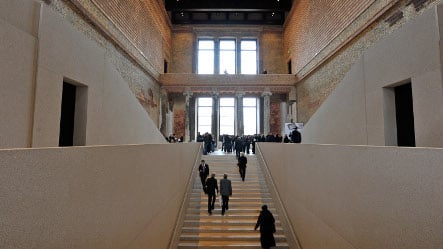The German government spent €200 million ($251 million) returning the neoclassical building, which was erected on the city’s renowned Museum Island in 1847, to its former glory.
“After 11 years, I’m a little reluctant to hand over the keys today,” joked Chipperfield, who won a competition to restore the building in 1997.
The New Museum is the fourth of five institutions to be completed on Museum Island, and city’s authorities hope that the renovated complex and UNESCO World Heritage Site will be able to rival Paris’ Louvre when completed.
“The opening marks an important day for the Museum Island but also for Berlin and the whole of the Federal Republic,” Hermann Parzinger, head of the Prussian Cultural Heritage Foundation which manages regional museums, told reporters.
Museum Island is located in the former communist east of the city and the restorations did not begin in earnest until the Berlin Wall fell 20 years ago. In that time, the capital has reshuffled its most prominent collections.
The New Museum, which will open to the public in October, will house the archaeological collections of the capital’s Egyptian Museum including the 3,400-year-old Egyptian bust of Nefertiti, which will have its own hall.
The institution, which got its name because it was built shortly after the city’s Old Museum, is roughly rectangular, with high ceilings creating a light and airy atmosphere.
One of the building’s focal points is a grand staircase, which leads to the top floors and is a lasting monument to its first architect, Friedrich August Stüler.
“The architecture is special because it is subtle enough not to cast a shadow over the historical artefacts exhibited,” Jörg Haspel, from Berlin’s department for the preservation of historical monuments, explained.
Chipperfield said the project had a “strange chronology” because the project had required him to work with material that had largely remained untouched for 60 years.
The architect, who has offices in London, Berlin and Milan, also said that he had tried to “capture the damage of war and the 60 years following.”
According to local media reports, Berlin city authorities hope the completed Museum Island project will attract up to four million visitors a year.



 Please whitelist us to continue reading.
Please whitelist us to continue reading.